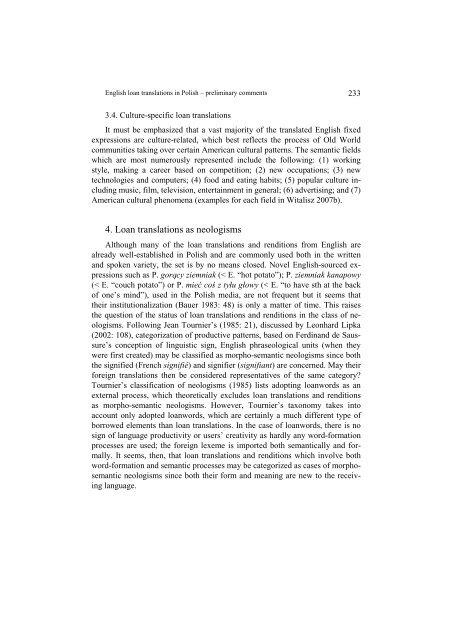s - Wyższa SzkoÅa Filologiczna we WrocÅawiu
s - Wyższa SzkoÅa Filologiczna we WrocÅawiu
s - Wyższa SzkoÅa Filologiczna we WrocÅawiu
You also want an ePaper? Increase the reach of your titles
YUMPU automatically turns print PDFs into web optimized ePapers that Google loves.
English loan translations in Polish – preliminary comments 233<br />
3.4. Culture-specific loan translations<br />
It must be emphasized that a vast majority of the translated English fixed<br />
expressions are culture-related, which best reflects the process of Old World<br />
communities taking over certain American cultural patterns. The semantic fields<br />
which are most numerously represented include the following: (1) working<br />
style, making a career based on competition; (2) new occupations; (3) new<br />
technologies and computers; (4) food and eating habits; (5) popular culture including<br />
music, film, television, entertainment in general; (6) advertising; and (7)<br />
American cultural phenomena (examples for each field in Witalisz 2007b).<br />
4. Loan translations as neologisms<br />
Although many of the loan translations and renditions from English are<br />
already <strong>we</strong>ll-established in Polish and are commonly used both in the written<br />
and spoken variety, the set is by no means closed. Novel English-sourced expressions<br />
such as P. gorący ziemniak (< E. “hot potato”); P. ziemniak kanapowy<br />
(< E. “couch potato”) or P. mieć coś z tyłu głowy (< E. “to have sth at the back<br />
of one’s mind”), used in the Polish media, are not frequent but it seems that<br />
their institutionalization (Bauer 1983: 48) is only a matter of time. This raises<br />
the question of the status of loan translations and renditions in the class of neologisms.<br />
Following Jean Tournier’s (1985: 21), discussed by Leonhard Lipka<br />
(2002: 108), categorization of productive patterns, based on Ferdinand de Saussure’s<br />
conception of linguistic sign, English phraseological units (when they<br />
<strong>we</strong>re first created) may be classified as morpho-semantic neologisms since both<br />
the signified (French signifié) and signifier (signifiant) are concerned. May their<br />
foreign translations then be considered representatives of the same category?<br />
Tournier’s classification of neologisms (1985) lists adopting loanwords as an<br />
external process, which theoretically excludes loan translations and renditions<br />
as morpho-semantic neologisms. Ho<strong>we</strong>ver, Tournier’s taxonomy takes into<br />
account only adopted loanwords, which are certainly a much different type of<br />
borro<strong>we</strong>d elements than loan translations. In the case of loanwords, there is no<br />
sign of language productivity or users’ creativity as hardly any word-formation<br />
processes are used; the foreign lexeme is imported both semantically and formally.<br />
It seems, then, that loan translations and renditions which involve both<br />
word-formation and semantic processes may be categorized as cases of morphosemantic<br />
neologisms since both their form and meaning are new to the receiving<br />
language.
















